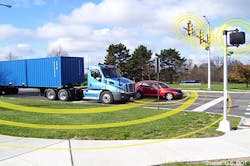Vehicle-to-vehicle communications face challenges, GAO says
Although technologies allowing highway vehicles to share critical safety information in real time have matured to the point of real-world testing, the Dept. of Transportation (DOT) and the automotive industry face significant technical, financial, legal and public acceptance challenges in deploying vehicle-to-vehicle (V2V) communications, the Government Accountability Office says.
In a report released Nov. 1, GAO said that based on its discussions with experts, DOT officials, automobile manufacturers and other stakeholders, technical challenges include finalizing the framework of a V2V communication security system and ensuring that other wireless users won’t interfere with the performance of V2V communications. Most of the cost issues associated with V2V relate to how these technical challenges are solved, GAO says.
Other challenges have little to do with how well the system works technically. For example, any deployment must address uncertainties related to potential liability issues posed by V2V technologies, GAO says. Also, the general public likely will have concerns over privacy, it notes. And even if V2V works, there’s the fundamental challenge of ensuring that drivers respond appropriately to warnings of potential collisions.
In V2V communications, vehicles share data using dedicated short-range communications (DSRC) - a technology similar to WiFi that covers a range of about 1,000 ft. to 1,600 ft. Not only is that range greater than today’s sensor based technologies, but it also enables alerts to potential collisions that sensors might not detect such as a stopped vehicle blocked from view or a moving vehicle at a blind intersection.
A year-long, real-world pilot of V2V technologies in light vehicles conducted in Ann Arbor, MI, by the University of Michigan’s Transportation Research Institute is set to end in February 2014. The National Highway Traffic Safety Administration has said that it plans to decide by the end of this year how it will proceed on connected vehicle systems for passenger vehicles. A decision on incorporating connected vehicle technologies into commercial vehicles could come in 2014, NHTSA has said.
Some experts, including the Assn. of Global Automakers, have expressed concerns that encroachment of WiFi enabled devices into the 5.9 GHz DSRC band could compromise the integrity of the V2V system.
V2V is part of a broader intelligent vehicle systems initiative within DOT that also includes vehicle-to-infrastructure (V2I) technologies. Applications of V2I could include wireless roadside inspections of commercial vehicles – a concept that the Federal Motor Carrier Safety Administration and various other government and private-sector partners have tested successfully.
In July, the National Transportation Safety Board recommended that NHTSA develop minimum performance standards for connected vehicle technologies and require their installation on all newly manufactured highway vehicles.
